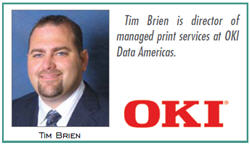Profit By Merging Managed Print, Managed Services
By Brian Albright, Business Solutions magazine
There are challenges, but integrating managed print with managed services can provide a new revenue stream.
Managed print services are an increasingly attractive offering for channel companies and their clients. These services can help your customers better control their printing operations, streamline processes, and reduce costs. For resellers, managed print offers new revenue opportunities across most vertical segments, providing longer-term contract agreements with higher margins and a shorter sales cycle.
 One important emerging trend is the integration of managed print with other managed services. “We see key partners getting into both managed services and managed print services, and those are among the more successful organizations,” says Tim Brien, director of managed print services at OKI Data Americas. “Managed services providers are now saying they need to get into print. Moving forward, they want to get all of these different applications on the network — document storage, network scanning, etc. Printing is viewed as a natural extension of their business.”
One important emerging trend is the integration of managed print with other managed services. “We see key partners getting into both managed services and managed print services, and those are among the more successful organizations,” says Tim Brien, director of managed print services at OKI Data Americas. “Managed services providers are now saying they need to get into print. Moving forward, they want to get all of these different applications on the network — document storage, network scanning, etc. Printing is viewed as a natural extension of their business.”
Integrating a managed print offering into an existing managed services suite is not necessarily straightforward, however. Print requires different resources and skillsets than other managed offerings. “MSPs and resellers sometimes struggle with it,” Brien says. “That’s why vendor partners are adding a huge amount of resources and infrastructure to help the partner face those challenges cost-effectively. That makes it easier for the reseller or MSPs to complete their service offerings, where otherwise they would have had to make large-scale investments.” As an example, cloud-based services from print vendors have eliminated significant costs for resellers.
Additionally, Brien says that managed print services will increasingly include more comprehensive offerings. “Document management, mobile printing, incorporation of green initiatives, and software application integration will all play a more significant role in the managed print services of the future,” he says.
More pervasive mobile computing technology will also drive demand for managed print services. End users often do their work on multiple types of mobile devices each day, and many of those devices may not have built-in print capabilities. Optimally, these customers want to be able to print any document from any device, regardless of the platform.
“We’re seeing more mobile devices being utilized for applications where everything is filled out on the mobile device, but a hard copy contract is printed and signed in person,” Brien says. “How do people get to that point of printing? You want to enable the users of these devices at any point to facilitate any action they want, including printing.”
Define Your Managed Print Services
For resellers, it will be important to educate existing and potential clients about exactly what their services will include and what the benefits will be. One critical challenge for end users had traditionally been determining exactly what “managed print services” means, because different vendors have taken different approaches.
“That definition can vary greatly from company to company,” Brien admits. “People have difficulty determining which company will best handle their needs. Who will give them the best service for their dollar? It may be that an organization could actually wind up increasing their overall spend, but gain much more value on the back end than if they simply tried to reduce their costs.”
The competitive landscape also is changing rapidly, which has put more pressure on the channel. More printing services and technology providers have direct offerings now, whereas in the past they relied almost exclusively on resellers. “There’s now a dual point of competition in the market,” Brien says. “Most of the large organizations out there are engaging their clients in a direct model, and that’s creating a huge amount of competition that was never in the market before.”
That, in turn, presents a challenge to resellers that have partnered with these firms in the past. As in other markets where suppliers have moved into direct sales, resellers will have to determine just how valuable those relationships are and evaluate how the suppliers work with their channel partners relative to their own direct sales force.
